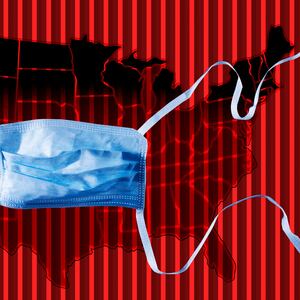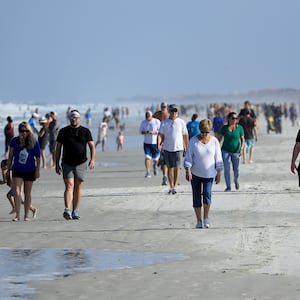In an attempt to curtail the spread of the coronavirus pandemic, most U.S. states have imposed extraordinary measures to restrict social contact, forcing millions of Americans to remain in their homes.
But several weeks into these public health orders urging residents to stay home, close down their businesses, and wear face masks to stop the spread of a virus predicted to claim between 100,000 and 200,000 lives, Americans have started to protest the restrictions and demand a return to normal life. Over the last few weeks, protesters in several states spurred a contentious national debate over public health versus economic well-being, pushing some states to lift stay-at-home restrictions—despite continuous reports of new coronavirus cases.
President Donald Trump, who has pushed to lift restrictions sooner rather than later, has provided governors with three-phase guidelines to guide their decisions on reopening.
The guidelines say that, in order to start lifting restrictions, states should have a two-week downward trend in new cases, enough hospital supplies and beds for incoming patients, and adequate testing measures to avoid a resurgence of the deadly virus.
One key roadblock to reopening, public health experts say, is that testing is not as widely implemented as it needs to be to reopen non-essential businesses without prompting a second wave of coronavirus cases. In some parts of the country, cases continue to climb. President Trump dismissed those concerns during his April 21 coronavirus briefing.
“Some states have far more capacity than they actually understand,” Dr. Anthony Fauci, a member of the White House coronavirus task force said. Social distancing has been successful and for that reason “we can think about reopening America,” he added. But he pleaded with governors and officials to do it “in a measured way.”
Despite the White House’s roadmap, and discouragement from health experts about removing lockdown measures too soon, these states are starting to reopen with varying degrees of caution.
GEORGIA
Georgia’s shelter-in-place order expired April 30. Gov. Brian Kemp on April 20 introduced a plan “to incrementally and safely reopen sectors” of the economy, saying that the state’s Department of Health had reported optimistic numbers. Trump said he disagreed “very strongly” with Kemp’s decision. Fauci advised Kemp “not to do that.”
“Reports of emergency room visits for flu-like illnesses are declining, documented COVID-19 cases have flattened and appear to be declining, and we have seen declining emergency room visits in general,” Kemp said, calling the change a “small step moving forward.”
- Gyms, fitness centers, barbershops, hair and nail salons, body art studios, bowling alleys, and massage parlors reopened April 24 following social distancing and “regular sanitation” rules.
- Church services resumed May 1 under social distancing.
- Theaters, private social clubs, and dine-in restaurants restarted April 27 at reduced capacity.
SOUTH CAROLINA
South Carolina Gov. Henry McMaster announced an executive order on April 20 to allow most retail and department stores to reopen with social distancing, with the exception of hardware and home-improvement stores.
“In light of the common sense being shown by the great people of South Carolina, we are ready to take some steps that will help South Carolina assure that our economic health is as strong as our public health,” McMaster said.
Retail and department stores began reopening at 20 percent capacity April 20, allowing curbside pickup and five customers per 1,000 square feet. State beaches, public piers, docks, and wharfs opened to the public.
South Carolina restaurants currently permit outdoor service only.
TENNESSEE
Tennessee Gov. Bill Lee said he would not extend the “safer-at-home” order, already lighter than restrictions in some states, beyond April 30. “The economic difficulty that’s been created by this, it has been devastating to our state, and the sooner we can begin to change that picture, the better,” Lee said.
The reopening plan states:
- Restaurants were allowed to reopen on April 27 on the condition that they limit capacity, enforce a maximum of six people per table, and sanitize surfaces every two hours. Employees are required to wear gloves and face masks.
- Retail stores began opening their doors on April 29 at 50 percent capacity. Workers must also wear personal protective gear. Stores must ban reusable bags and offer reserved shopping hours for those at high-risk, such as the elderly.
- Gyms and state parks reopened May 1 with social distancing guidelines in place.
- Services such as barbershops, salons, and massage and tattoo parlors will remain shuttered until further notice.
TEXAS
Texas Gov. Greg Abbott announced on April 27 that he would allow the statewide stay-at-home order to expire on April 30, citing a decline in the infection rate for over two weeks. “Texas is a very diverse state with a very diverse geography. The fact is, not all counties are alike,” the governor said.
Abbott issued a series of executive orders April 17 that would allow stores open for retail-to-go starting April 24. He said that after seeing “glimmers that the worst of COVID-19 may soon be behind us,” he created a team of medical advisers and business leaders to figure out how to safely reopen the state’s economy.
“They will work together to develop a medical architecture to comprehensively test and trace COVID-19 that will enable Texas to gradually and safely begin the process of returning to work and returning to other activities while we wait for the immunizations that will end the threat of COVID-19,” Abbott said.
The reopening plan states:
- Phase One: Restaurants, retail stores, libraries, museums, state parks and movie theaters were allowed to reopen on May 1 with social distancing guidelines in place. Churches and medical practitioners also reopened their doors.
- Phase Two: Businesses such as bars gyms, barber shops, and hair salons will be allowed to reopen as early as May 18 as long as data does not show another spike in cases.
- Schools will remain closed through the end of the academic year.
- Hospitals in the state were allowed to perform elective procedures starting April 21, though they must reserve 25 percent of their beds for COVID-19 patients.
OKLAHOMA
Oklahoma Gov. Kevin Stitt announced that the first of three phases of reopening would begin April 24, when personal care businesses could resume operation. Oklahoma did not issue a formal stay-at-home order to residents, though it did implement other restrictions.
“We are making decisions for Oklahomans that are based on the data in our state and to protect the health of Oklahomans,” Stitt said.
As of April 24, Oklahoma allowed a wide range of businesses and activities to restart with social distancing in place: personal care businesses such as salons, tattoo parlors, and pet groomers, elective surgeries, and state parks.
Restaurants, gyms, churches, offices, movie theaters, museums, and sports facilities reopened May 1 at limited capacity.
Bars and schools remain closed.
VERMONT
Vermont Gov. Phil Scott announced April 17 that the state would begin a phased approach to returning to public life, authorizing low-density workplaces like construction sites to resume operations with no more than two employees on-site at a time, according to NBC 5.
“These forecasts show we can continue to slow the number of new COVID-19 cases if we continue to stay vigilant, meaning staying home, avoiding large gatherings, staying six feet away from others, using a cloth face covering when in public and washing our hands," Scott said. "But what these trends also show is that, with the right precautions, we can take small steps to get more Vermonters back to work and avoid a spike in cases that would put lives at risk."
The reopening plan states:
- Vermont retailers were allowed to reopen from April 17, but customers can only pick up goods curbside.
- Services operated by a single worker, such as realtors, attorneys, or property managers, can resume operations.
- Outdoor or construction jobs can resume with no more than two employees on-site at a time.
- The state’s “Stay Home, Stay Safe” order will remain in place until May 15, encouraging individuals to limit non-essential travel.
FLORIDA
Florida Gov. Ron DeSantis announced on April 17 that the state’s beaches and parks could reopen if done safely, and Jacksonville was the first city to take him up on the offer. Florida’s beaches became a flashpoint of coronavirus controversy when images of carefree spring breakers defying social distancing guidelines shocked the nation. Many tourists later fell ill, and Florida’s officials faced criticism for allowing the beaches to remain open.
“Do it in a good way,” DeSantis told residents ahead of the partial reopening. “Do it in a safe way.”
On May 4, the state’s stay-at-home order expired except in the state’s most populous counties: Miami-Dade, Broward, and Palm Beach. Restaurants and retail stores elsewhere resumed operations at 25 percent capacity.
Local officials reopened state beaches for walking, biking, hiking, fishing, running, swimming, and surfing. Groups of 50 people or more are still banned.
Church services resumed.
OHIO
Ohio Gov. Mike DeWine said April 22 that the state’s “shelter-in-place” order would not extend past April 30, and he was hoping to resume public life as early as May 1. It comes as Ohio’s largest prison has suffered an extreme coronavirus outbreak, with three-quarters of inmates testing positive.
The re-opening plan states:
- Companies that can set protocols for protecting employees and customers can reopen on May 1.
- Schools will remain closed for the rest of the academic year.
MONTANA
Montana Gov. Steve Bullock announced on April 22 a phased reopening for the state after the expiration of its stay-at-home order April 26.
“There are very few states in the country that can say they have seen the number of positive cases decline over these past weeks. Montana can say that because, together, we have made that decline in cases possible,” Bullock said.
- Churches reopened with social distancing measures as of April 26.
- Schools reopened starting May 7, among the first in the nation to do so.
- Retail businesses resumed operations April 27 with limited capacity.
- Restaurants, bars, breweries, and distilleries reopened May 4 with social distancing in place.
- Movie theaters, gyms, and other places where social distancing is difficult will remain closed.
MICHIGAN
Michigan Gov. Gretchen Whitmer extended the state’s stay-at-home order until May 28, but eased some restrictions on public activities after intense criticism for the public health mandate.
“While it’s understandable to be lured by the phenomenal beauty of this great state and hit the road, we know that our rural hospitals are not equipped to meet an influx of people who may bring or spread the virus,” Whitmer said.
The order also allows:
- Residents may travel in-state, motorboat, and golf, though they cannot use a golf cart.
- Non-essential stores may reopen, but only using curbside pickup and delivery.
- Manufacturers are allowed to reopen May 11 with social distancing precautions like temperature testing in place. Carmakers are among the largest employers in the state.
- Big-box retailers can open up garden centers and areas dedicated to selling carpeting, flooring, furniture, plants, or paint.
- Landscapers, lawn-service companies, plant nurseries, and bike repair shops can also resume operation but must adhere to social distancing.
- All residents now required to wear face masks in enclosed public spaces.
ARKANSAS
Arkansas Gov. Asa Hutchinson on April 30 announced the first phase of reopening the state, stating that his office would continue to monitor the number of new cases before continuing to ease restrictions.
“Even if we were perfect in our prevention of COVID-19 transmission here in Arkansas, we’re not an island,” Arkansas Department of Health Secretary of Health Dr. Nathaniel Smith said. “We’re surrounded by other states, most of which have higher rates of COVID-19 per population.”
Starting on May 4, the order allowed:
- Gyms, fitness centers, and indoor athletic facilities to resume operations.
- Barbershops and hair salons to open May 6.
- Residents can open limited dine-in service May 11, but will only be able to operate at a third of normal capacity and groups larger than 10 are still banned.
- Places of worship can begin having in-person events, but online services are still encouraged.
HAWAII
Hawaii Gov. David Ige announced on May 5 a plan to ease the state’s current public health order.
“We have some of the lowest numbers of cases in the country, and we have flattened the curve,” Ige said. “Now we can continue our phased approach to reopening our local economy.”
The order, beginning on May 7, states:
- Shopping malls can open, provided they enforce social distancing guidelines and reduce capacity.
- Car washes, pet grooming, and a number of in-person retail businesses will be allowed to open with social distancing.
- Elective surgery will begin in hospitals.
- Beaches will be open to exercising, such as jogging or walking, but residents are not allowed to stay for long periods of time.
- The state is still discouraging visitors to the Islands.
- Two-person groups are now allowed to fish.
KENTUCKY
Kentucky Gov. Andy Beshear announced on April 29 the state’s plan to gradually reopen in three phrases.
“We’ve got to do this right. I believe we can do this right,” Beshear said. “When we phase back into work, remember, you don’t need an in-person meeting. Use the telephone. And now that we are starting to open up health care, see your doctor if you need to.”
The plan allows:
- Manufacturing, construction, car dealerships, or other professional services to resume operation at a 50 percent capacity starting on May 11.
- Horse racing to resume on May 11 but without fans present.
- Dog grooming and boarding will be allowed to reopen on May 11.
- Outpatient surgery and prosecutors will be allowed starting May 6.
- Retail and places of worship will reopen on May 20.
- Starting on May 25, social gatherings of fewer than 10 people are allowed.
- Barbers, salons, and other personal-care businesses will be allowed to be open.
IOWA
Gov. Kim Reynolds revealed her plan on April 27 for reopening certain businesses despite a rise in coronavirus cases, saying that “we must learn to live with COVID virus activity without letting it govern our lives.” The governor said other restrictions would continue to stay in place until May 15, and the changes do not apply to Iowa’s most populous areas.
- Malls, restaurants, gyms, libraries, and retail stores reopened May 1 at reduced capacity. Restaurants are not allowed to offer tables to more than six people and all tables must stand six feet apart.
- In-person religious gatherings and services restarted May 1 on the condition that attendees adhere to social distancing guidelines.
INDIANA
Indiana Gov. Eric Holcomb, whose stay-at-home order expired on May 1, has rolled out the first stage of loosening virus restrictions by allowing critical businesses to open. Starting on May 4, residents were allowed to have gatherings of up to 25 people—with social distancing—and state government offices with limited public interaction were opened.
Retail and commercial businesses were also opened but at 50 percent capacity. Starting May 11, restaurants and bars can open at 50 percent capacity, and personal services such as hair salons, barbershops, nail salons, and tattoo parlors can open by appointment only.
IDAHO
Idaho Gov. Brad Little permitted his state’s stay-at-home order to end April 30. Churches have begun conducting services at reduced capacity.
Little said some non-essential businesses could reopen after that if they “prepare operational plans” that include limits on the number of people in a business at a time.
The order excludes some “non-essential” businesses like nightclubs, bars, and restaurants for dine-in, gyms, hair and nail salons, and entertainment centers, his office said.
ALABAMA
Gov. Kay Ivey allowed Alabama’s stay-at-home order to expire April 30, calling the new guidelines “safer-at-home” to reflect the state encouraging but not requiring residents to stay put. Retail stores opened at 50 percent capacity. Public parks and beaches opened for recreation.
ALASKA
Alaska Gov. Mike Dunleavy allowed personal services, businesses, and restaurants to reopen April 24, but with strict social distancing guidelines.
To date, hair salons can only admit customers by reservation, and restaurants can only have 25 percent of their normal capacity. Despite the loosening of restrictions, Dunleavy has said the state is not in a rush to reopen and is only responding to its generally low infection rate.
“You’ll see the numbers go up but you want to look at the bed capacity, the numbers recovered, and a whole host of other metrics,” Dunleavy said.
KANSAS
Kansas Gov. Laura Kelly did not renew the state’s stay-at-home order that ended May 3, allowing restaurants, houses of worship, and retail stores to open with proper social distancing guidelines. Despite not extending the order, all bars, nightclubs, casinos, and gyms are still closed.
On May 18, the state will begin its second phase of reopening, which will allow most businesses to open their doors and gathers more than 10 people. By June 15, the state expects to allow groups of 90 people.
MISSISSIPPI
Mississippi Gov. Tate Reeves ended the state’s shelter-in-place order April 27. Retail stores opened for curbside pickup and delivery. Gyms, salons, and spas remain closed.
NORTH DAKOTA
North Dakota does not have a formal stay-at-home order, but all non-essential businesses were closed until May 1. Restaurants, bars, salons and grooming businesses, movie theaters, and gyms are all allowed to open under limited capacity.
COLORADO
Colorado’s shelter-in-place order expired April 26, allowing offices to reopen. Retail stores resumed sales via curbside pickup.
On May 1, hair and nail salons, tattoo parlors, tailors, pet groomers, massage therapists, and personal trainers were allowed to begin providing services to individual clients or small groups.
MAINE
Maine’s shelter-in-place order ended April 30 in favor of “safer-at-home guidelines.” State parks reopened, as did salons and pet groomers. Restaurants, gyms, and retail stores are slated to reopen in June.
MISSOURI
Gov. Mike Parson did not renew Missouri’s shelter-in-place order after May 3 and instituted one of the widest-ranging reopening orders in the nation. All businesses, including large event venues, are allowed to resume operations provided appropriate social distancing between customers was enforced.
NEBRASKA
Nebraska did not issue formal shelter-in-place restrictions to residents, but it did close restaurants, salons, tattoo parlors, and other personal care establishments. Gov. Pete Ricketts allowed them to reopen under social distancing rules May 4, as well as houses of worship and childcare facilities.
UTAH
The Beehive State did not issue a formal stay-at-home order to residents, but restaurants, gyms, salons, and other personal care establishments were closed until April 30. They reopened the following day at limited capacity.
WEST VIRGINIA
West Virginia’s stay-at-home restrictions on businesses ended May 4, with restaurants opening for outdoor service and retail stores and salons operating at limited capacity. Gov. Jim Justice has told residents they will be “safer at home” than out and about.
WYOMING
Wyoming did not issue a shelter-in-place order to residents, but gyms, salons, tattoo, and massage parlors were closed until May 1. They have been allowed to reopen at limited capacity. Whether restaurants and churches can resume operations varies by county, according to local reports.
CALIFORNIA
Gov. Gavin Newsom, the first in the country to issue a statewide shelter-in-place order, began easing the Golden State’s restrictions from May 8. Retail stores, like clothing shops, bookstores, sporting goods, and florists, will be allowed to open for pickup and delivery.
Manufacturers are permitted to resume operations the same day with break rooms closed and social distancing in place between workers.
Residents are still ordered to stay home.












